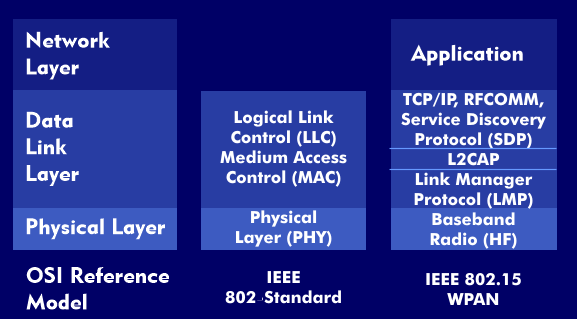IEEE 802.15
The IEEE 802.15 working group is working on standards for small- area radio networks as an alternative to the wireless standard according to IEEE 802.11. The working group uses the name Wireless PersonalArea Networks(WPAN) and specifies wireless communication within the Personal Operating Space( POS). Due to the low transmission power, the distance range to be bridged is between 50 m(868 MHz) and 15 meters (2.4 GHz), depending on the ISM band used.
The working group is concentrating on the two lower layers of the OSI reference model, the physical layer and the MAC layer. Standardization is taking place relatively quickly because the experts are strictly following the Bluetooth specification.
802.15.1: This IEEE working group 802.15.1 has developed the actual WPAN standard based on Bluetooth with the specifications for the MAC layer and the PHY layer. The specifications are compatible with Bluetooth 1.1. The HomeRF Alliance and the Bluetooth Alliance are involved in this standard. This is a simplification of 802.11. The ISM band at 2.4 GHz is used for this technology, the data rate is 732 kbit/s, and the bridgeable distance is 10 meters.
80215.2: Coexistence: Recommended Practice for Wireless Personal Area Networks Operating in Unlicensed Frequency Bands. This working group is working on the coexistence of 802.15 and 802.11b specifications in the 2.4 GHz band.
802.15.3: Wireless Medium Access Control and Physical Layer Specifications for High Data Rate Wireless Personal Area Networks( HDR WPAN) with transmission rates of 50 Mbit/s. 802.15.3 extends the scope of the WPAN specification to higher bandwidth technologies, as also specified in 802.11a and 802.11g at 54 Mbit/s. This working group has adopted the Protocol Adaptation Layer( PAL) for Wireless FireWire.
802.15.3a: The Alternative Physical Layers working group is investigating the possibilities of alternative radio technologies, including Ultra Wideband( UWB) for Wireless USB. This working group disbanded in 2006.
80215.3.c: The 802.15.3c working group is concerned with a gigabit WLAN operating in the 60 GHz band with a data rate of over 2 Gbit/s.
802.15.4: The 802.15.4 working group is working on Low Power and Lossy Networks( LLN) with low transmission rates up to 250 kbit/s, which requires extremely little power. This technique is called Low Rate WPAN( LR-WPAN) and is used in wireless sensor networks(WSN). One implemented technology is ZigBee. For 802.15.4, frequencies of 868/915 MHz and 2.4 GHz are used. The bridgeable distance is 75 m.
802.15.4a: Development of alternatives for the physical layer. Ultra-wideband (UWB) with low loss and data rate is included. 802.15a is intended to significantly improve transmission quality and battery life for wireless sensing and control applications. This standard uses CSS modulation. This standard targets applications such as real-time location system( RTLS) for industrial control, sensor networking, and medical.
802.15.4b: This standard aims to improve the 4a version, relies on simplified algorithms, and uses Parallel Sequence Spread Spectrum( PSSS) for better interference immunity.
802.15.5: Under the title Wireless Mesh Network( WMN), the 802.15.5 working group is concerned with the construction of complete Wireless Personal Area Networks (WPAN).
In addition, more recent developments are being carried out by several Technical Groups (TG). These include:
802.15 TG3: The 802.15 TG3 working group specifies an extended scope for high data rateWPANs (HDR WPAN). It is concerned with data rates between 11 Mbit/s and 55 Mbit/s and with low power consumption.
802.15 TG4: TG4 elaborates the specifications for Low Power and Lossy Networks (LLN) with extremely low power consumption, allowing batteries to run for months and years. Typical applications are for sensor networks, smart badges, home monitoring equipment, etc.
802.15 TG5: The working title of TG5 is mesh networks. It is about complex WPAN structures.
802.15 TG6: Body Area Networks( BAN) are developed by the working groups TG6 and TG7.
802.15 TG7: Like TG6, TG7 is concerned with Body Area Networks (BAN) and specifies procedures for how such networks can communicate via visible light.
802.15.6: Wireless Body Area Network (BAN).
802.157: 802.15.7 works at Short-Range Wireless Optical Communication Using Visible Light, LiFi, Physical and MAC Layer Standard for Visible Light Communication( VLC).
802.1513:802.15.13 increases the bandwidth to 1 GHz compared to G.hn and achieves data rates of 10 Gbps. In addition, the physical layer supports pulse modulation and, together with the media access method, also the MIMO method.

